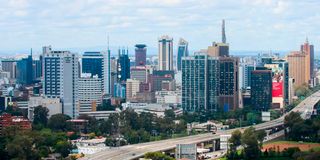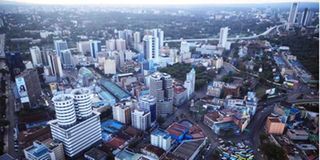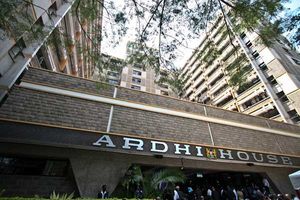
Nairobi City Skyline on April 27, 2023.
Nairobi’s skyline is about to change – and the city, as we have been accustomed, is bound to be different after the county government announced that it will grow towards the sky. There is nothing wrong with that if you ask me. But we should have a planned city, not the kind of mathogothanio (haphazard) growth now happening in Parklands, Kilimani and elsewhere.
Dear Nairobi urban planners, both current and former: Are you happy to look back and say, ‘That is my legacy, that is how I planned the City when I was there’.
For those of us who look at Nairobi’s urban character from its colonial formation, the desire to reconfigure the City at this point is essential.
We should abandon the campsite mentality and design a city worth its name. This means that, the residents must have a say on the kind of city they want. Nairobi is no longer the 1899 railway encampment – and even then, the pioneer administrator, John Ainsworth, worried about a town emerging without any plan.
In his wisdom, he had clearly marked the city into a railway station, government offices, an Indian bazaar, African residences, European business premises, and European residential areas of Hill (now Community), Muthaiga, and Parklands. That is the character that Nairobi took.
In essence, if you look at it today, Nairobi was designed with a colonial white privilege mentality. The wooded areas, the leafy suburbs, were reserved for either the Europeans if you look at Muthaiga as an example, or for Indians who were given Parklands. The treeless plains were the African living quarters, and more than 120 years later, we have not thought of planting trees in Eastlands.
The question now is how Nairobi should look going forward. The Nairobi population has exploded beyond our imaginations, and the railway camp has no space for growth. It has started to eat into the coffee farms of Kiambu and has swallowed all the former cattle ranches that stretched from Roysambu to Juja. But that has not offered us any solution and that is why it is important to rethink the city planning.
The problem is that the Governor has no master plan for the kind of city he wants, nor has he come up with an architectural design for the kind of houses that the future Nairobi should have. Instead, the city fathers have left all this to the imagination of investors and the whims of fundis, and we will end up with a city that has no green areas, no parks, and houses with no natural lighting space.

An aerial shot of a section of Nairobi. Many buildings and structures have come up, destroying the city’s original plan of independence Kenya.
We must admit that Nairobi has no further growth space, and from the initial 2537 hectares in 1928, the boundaries have yet to be revised since 1963, and we have to figure out how to accommodate the 5 million plus residents within the current 70,000 hectares. If we are to do away with zoning, we must sit back and think about the initial intentions. The South African urban planners who planned Nairobi as a colonial city are long gone. Their imaginations on what constitutes a future city have had challenges – though we have been building on their reasoning.
I recently drove through Parklands, and the entire place is a construction site. You only need to look at the concrete jungle emerging in Parklands to understand Nairobi’s fate in the hands of uncontrollable developers. The buildings are an eyesore and have erased the previous beauty of the wooded terrain. (I pray that they don’t encroach on City Park!)
What worries me is the impunity that the developers have acquired – and the inability of the County government to stop unauthorised construction. Let me cite one case. The High Court had ordered the County government to stop construction on Taza Lane and City Park Drive. But in a twist that shows how powerless City Hall has become, the Country Secretary, Patrick Akivaga, recently swore an affidavit saying that the enforcement officers were unable to stop construction after officers from the “National Police Service were deployed to the site to ensure resumption of construction works and to supervise the same”.
He goes on: “Attempts to reason with the police officers and to bring to their attention the existence of a court order herein stopping the construction works on the suit property were made in vain…these ensuing circumstances are beyond our control and manpower, and they have completely derailed and made docile all our attempts to enforce the court orders.” When the city fathers say they have lost authority to stop one construction, even with a Court order, then where will residents turn to?
In Parklands, we have a case where a building has been built beacon to beacon and there is no space for fire escape. Essentially, Parklands is losing its woodland, its beauty, and its history.
Without zoning, you will see multi-storey buildings within Muthaiga, and on March 11, 2024, the County Assembly was told that there is an application to change the plot adjacent to the US ambassador’s residence to a residential hotel. The assembly was told that the application was approved in the urban planning technical committee meeting held on December 9, 2023. Once we open the space, there will be no turning back. My only fear is without a plan, we end with haphazard developments.
There is also the idea of demolishing the age-old Eastland estates owned by the county government and building President William Ruto’s “affordable” houses. The controversy surrounding the housing tax aside, this is a chance to develop an area that had hitherto been neglected. But as we do that, I suggest that we retain some of the houses as heritage sites. Future generations should be able to see some of the signature colonial houses, which should be gazetted as monuments.
We must remember that the 1947 Nairobi Master Plan, which was borrowed from South Africa, intended to create a residential area based on race grounds. While race as a factor has collapsed, it is important not to erase, in toto, that history of urban planning. More so, we can re-create Eastlands with unique public open spaces, flower gardens, and road networks. It is important to point out that Eastlands was an afterthought in the initial design of Nairobi and continued to be treated as such in the provision of services. It was a place for labourers, and initially, they were controlled by Vagrancy laws and Kipande. What emerged later were wretched structures and unplanned hovels that started from Mathare Valley. On this, the urban planners have failed Kenyans, and that is why the entire east of the City is an insult to urban planning – or what I am calling mathogothanio.
Look at an estate such as Buruburu and Umoja One. They were designed with wide roads, clear drainage, and they all had a pattern. Then madness set it – and, as City Hall watched, we destroyed these two estates’ beauty.
The point I want to make is that Nairobi needs to grow to the skies. But as we do that, let us create a city with some sense of planning. We cannot just sit back and assume that developers are civil. They will interpret the end of zoning as a ticket to urban chaos. It is time for Governor Sakaja to listen to the voices of urban planners. They are telling him to consult experts. But if his officials are frightened to face the developers even with a Court order, then we are having a major problem. When the central government grabs the city sewerage land, and we all keep quiet, then we have a problem.










